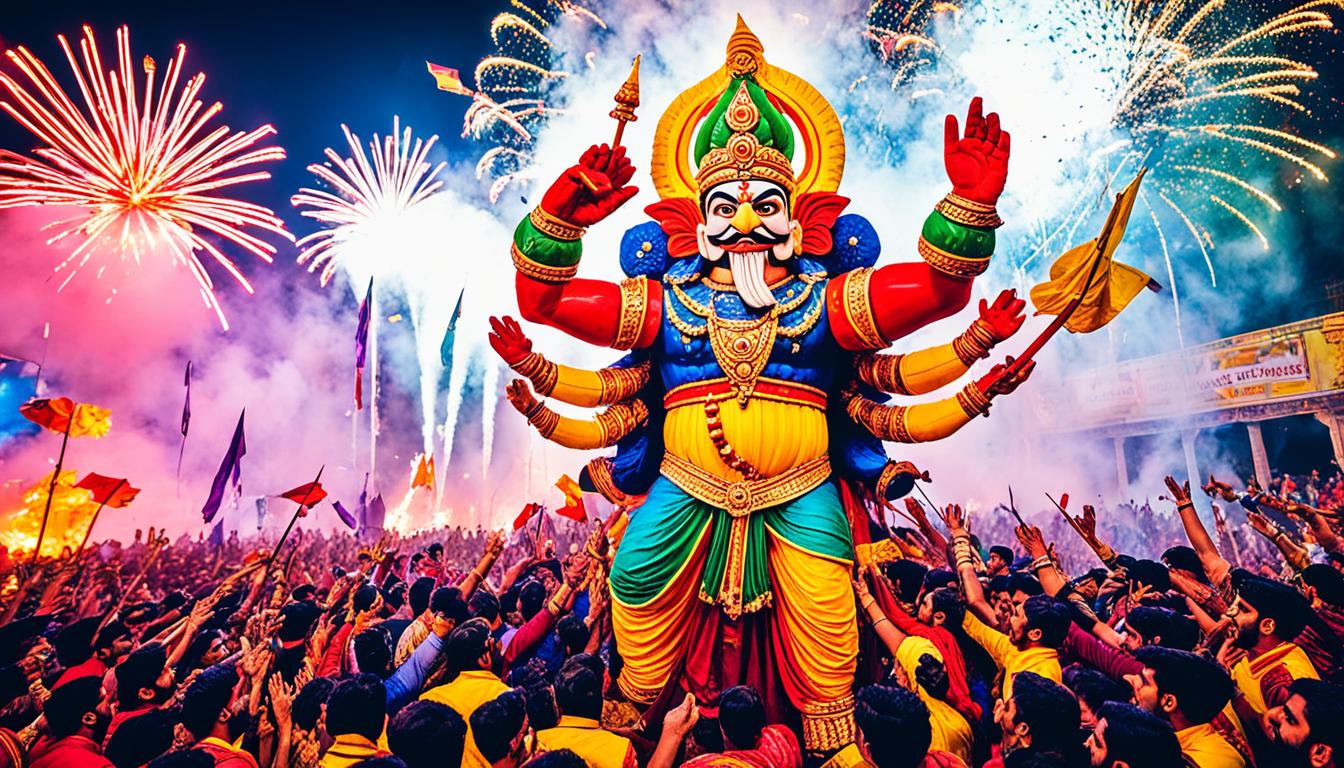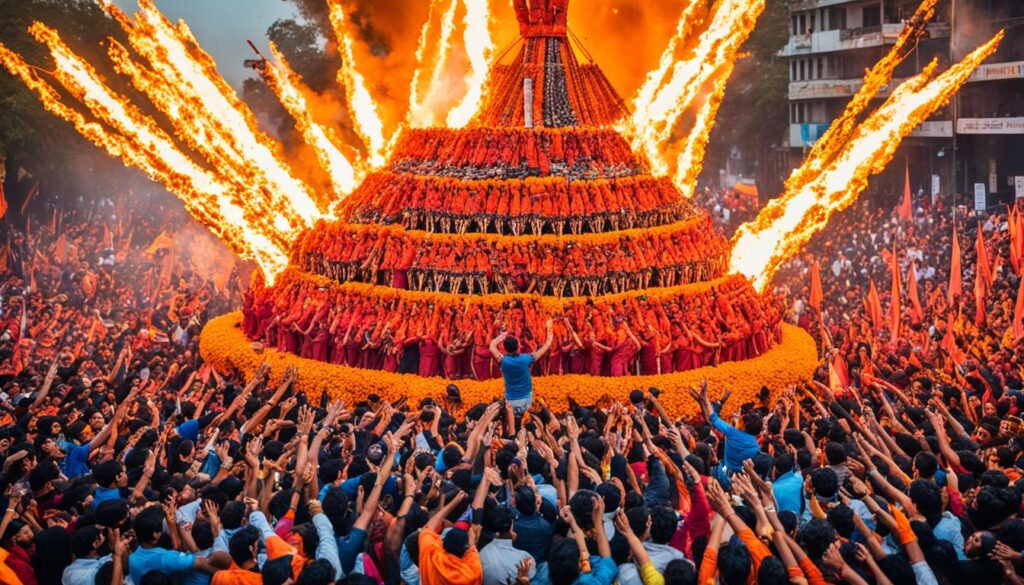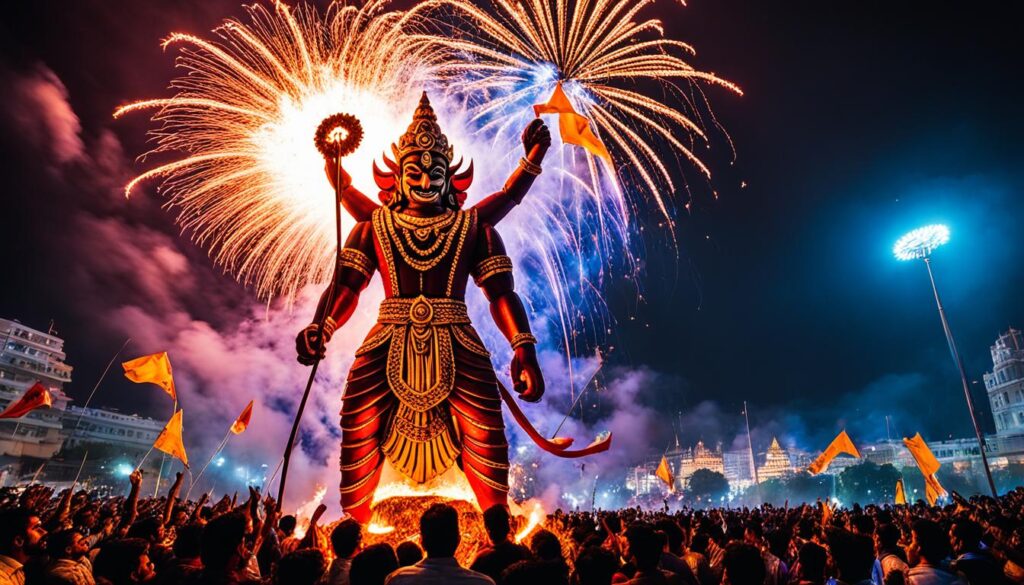
Celebrate Dussehra in India: Traditions & Joy
Did you know that Dussehra, also known as Dashmi, is celebrated by over 800 million people in India alone? This vibrant Hindu festival marks the culmination of the nine-day Navratri celebration and holds immense cultural and religious significance. It is a joyous occasion that symbolizes the victory of good over evil and is celebrated with great enthusiasm and fervor across the nation.
From the mythological narratives to the elaborate rituals and diverse celebrations, Dussehra captivates the hearts and minds of millions. In this article, we will explore the significance of Dussehra, the vibrant celebrations, the rituals and traditions associated with the festival, and its historical and cultural importance. Join us on this journey as we delve into the fascinating world of Dussehra in India.
The Significance of Dussehra
Dussehra is a festival of immense significance in Hindu mythology. It represents the glorious victory of truth, love, and righteousness over evil and hatred. The festival is deeply rooted in the story of Lord Rama’s triumph over the ten-headed demon king Ravana and the rescue of his wife, Goddess Sita.
This mythological significance of Dussehra holds great universal importance as it symbolizes the eternal battle between good and evil. Lord Rama’s conquest embodies the victory of light over darkness and the restoration of balance in the world.
Dussehra showcases the power of righteousness, bravery, and devotion, reminding us that good will always prevail over evil. It serves as a reminder to stay steadfast in our pursuit of truth and justice, even in the face of adversity.
“From darkness to light, from ignorance to knowledge, Dussehra marks the triumph of positivity and the transformation of souls.” – Unknown
This festival resonates with people of all faiths around the world, as it encapsulates universal principles such as peace, love, togetherness, fearlessness, and purity. It inspires individuals to embody these virtues in their lives, fostering a sense of unity and harmony among diverse communities.
The significance of Dussehra goes beyond religious boundaries, encouraging individuals to embrace the victory of good over evil in their personal and social lives. It serves as a timeless reminder of the power of righteousness and the strength of the human spirit.
https://www.youtube.com/watch?v=hYPf4DlXurI
Symbols of Dussehra
| Symbol | Meaning |
|---|---|
| The effigy of Ravana | Representation of evil and its defeat |
| Lord Rama | Embodiment of righteousness and valor |
| Goddess Durga | Symbol of feminine power and strength |
| Vijayadashami | Celebration of victory and new beginnings |
Dussehra Celebrations in India
Dussehra celebrations in India are a vibrant and enchanting spectacle, attracting people from all walks of life to partake in the festivities. This grand festival, also known as Vijayadashami, is an annual celebration of the victory of good over evil. Dussehra holds a special significance in Hindu mythology, commemorating the triumph of Lord Rama over the ten-headed demon king Ravana.
As the festival approaches, the streets of India become a cultural tapestry, adorned with colorful decorations and vibrant processions. The air is filled with excitement and enthusiasm as communities come together to celebrate this auspicious occasion. People of different faiths join hands in the celebration, emphasizing the universal message of unity and the triumph of righteousness.
The festival of Dussehra marks the beginning of the festival of Diwali, also known as the Festival of Lights, which further magnifies the celebrations. Diwali brings a sense of joy and prosperity, with families illuminating their homes with clay lamps and fireworks.
The highlight of Dussehra celebrations is the reenactment of the Ramayana, known as Ramlila. Artists and actors perform this epic tale in open-air theaters, captivating the audience with their skillful portrayal of the characters. The Ramlila performances capture the essence of the ancient Hindu scriptures and serve as a reminder of the powerful message of good triumphing over evil.
“Dussehra is a celebration of the ultimate victory of righteousness over wrongdoing. It reminds us that no matter how strong the forces of darkness may seem, goodness will always emerge victorious.”
The festival culminates in the burning of effigies of Ravana, his brother Kumbhakarna, and his son Meghnad. This symbolic act represents the eradication of evil from society and the triumph of good over evil. The effigies, towering high in the night sky, are set ablaze amidst cheers and applause, creating a spectacular sight.
Amidst the festivities, traditional music and dance performances fill the air, adding to the joyous ambiance. People dress in their finest traditional attire, exchanging greetings, and offering prayers at temples. The fragrance of incense and the mesmerizing beats of traditional drums add to the spiritual atmosphere.
To capture the essence of the Dussehra celebrations in India, here is a table showcasing the unique traditions and cultural practices observed in different regions:
| State | Celebrations |
|---|---|
| West Bengal | Durga Puja: Elaborate idols, pandal decorations, and cultural performances |
| Gujarat | Garba and Dandiya Raas dance performances |
| Himachal Pradesh | Lord Raghunath’s grand procession |
| Delhi | Spectacular Ramleela performances |
| Punjab | Fasting and worship of goddess Shakti |
| Tamil Nadu | Doll shows and worship of goddesses Durga, Lakshmi, and Saraswati |
| Uttar Pradesh | Grand Ramleela performances |
| Chhattisgarh | Unique rituals and worship of Devi Danteshwari |
| Karnataka (Coorg) | Vibrant folk dances and grand parade |
| Tamil Nadu (Kulasekarapattinam) | Vibrant costumes and trance dance |
These diverse celebrations reflect the rich cultural tapestry of India, emphasizing the unity and love that underpins the festival. Dussehra brings people together in the spirit of joy and harmony, reinforcing the belief in the power of good to overcome evil.
Dussehra Rituals and Traditions
Dussehra, a prominent Hindu festival celebrated across India, is characterized by a rich tapestry of rituals and traditions. These customs are deeply rooted in mythology and symbolize the victory of good over evil. Let’s explore some of the key rituals and traditions associated with Dussehra:
Ramlila Performances
One of the highlights of Dussehra celebrations is the enactment of Ramlila, which showcases scenes from the epic Ramayana. These elaborate theatrical performances capture the essence of Lord Rama’s journey, his victory over the demon king Ravana, and the rescue of Goddess Sita. Ramlila stages are set up in different parts of the country, with passionate actors bringing the mythological characters to life.
Worshipping Goddess Durga
Dussehra is also a time for devotees to worship Goddess Durga, the divine feminine force of power and protection. Elaborate puja rituals are performed, accompanied by recitations of sacred hymns and chants praising the goddess. The devotees seek her blessings for strength, prosperity, and victory over evil forces.
Burning Effigies
A significant tradition associated with Dussehra is the burning of effigies, representing the mythological characters of Ravana, Kumbhakarna, and Meghnad. These towering effigies, filled with firecrackers, are set ablaze to depict the ultimate triumph of good over evil. The burning of the effigies is a powerful visual representation of the victory of righteousness and serves as a reminder of the consequences of embracing darkness.

Dussehra Celebrations in Different States of India
Dussehra, the festival symbolizing the victory of good over evil, is celebrated with great fervor and enthusiasm in various states of India. Each state adds its unique touch to the festivities, making Dussehra a vibrant and culturally diverse celebration across the country.
1. West Bengal – Durga Puja
In West Bengal, Durga Puja takes center stage during Dussehra. Elaborate pandals (temporary structures) are set up, showcasing artistic depictions of goddess Durga. Devotees indulge in prayers, cultural performances, and processions. The city of Kolkata is particularly known for its grand celebrations and energetic immersion of the idols in the river.
2. Gujarat – Garba Dance
Gujarat celebrates Dussehra with the famous Garba dance, a traditional folk dance performed around a lit lamp or an idol of goddess Amba. People dance in rhythmic circles, clad in colorful attire, accompanied by traditional music. The vibrant energy and enthusiasm make Gujarat’s Dussehra celebrations a sight to behold.
3. Himachal Pradesh – Lord Raghunath Procession
Himachal Pradesh has a week-long Dussehra celebration, focusing on Lord Raghunath. The festivities include a grand procession of Lord Raghunath’s idol, accompanied by traditional music, dance, and vibrant cultural performances. The state’s picturesque landscapes provide a stunning backdrop to the joyful celebrations.
4. Delhi – Ramleela Performances
In Delhi, Dussehra witnesses stunning Ramleela performances, which are dramatic reenactments of scenes from the epic Ramayana. Elaborate sets, colorful costumes, and talented actors bring the story of Lord Rama to life. These performances attract a large audience, creating a festive atmosphere in the city.
5. Punjab – Fasting and Worship of Goddess Shakti
Punjab observes fasting and worships Goddess Shakti during Dussehra. Devotees observe strict rituals, seeking the blessings of the divine mother. The celebrations are accompanied by devotional songs, prayers, and community gatherings, creating a spiritual ambiance.
6. Tamil Nadu – Doll Shows and Worship of Goddesses
Tamil Nadu celebrates Dussehra with elaborate doll shows called “Golu.” Households display intricately arranged dolls depicting various mythological characters and deities. The festival also involves the worship of Goddesses Durga, Lakshmi, and Saraswati. Tamil Nadu’s Dussehra celebrations showcase the rich cultural heritage of the state.
7. Uttar Pradesh – Grand Ramleela Performances
In Uttar Pradesh, Dussehra is marked by grand Ramleela performances. These theatrical presentations depict the life story of Lord Rama, showcasing his heroic deeds and ultimate victory over evil. The performances attract large crowds, fostering a sense of unity and cultural pride among the people.
8. Chhattisgarh – Worship of Devi Danteshwari
Chhattisgarh celebrates Dussehra with unique rituals and the worship of Devi Danteshwari. The festival brings together people from different communities and tribes, who participate in vibrant processions, traditional dances, and music performances. The celebrations reflect the cultural diversity and unity of the state.
9. Karnataka – Coorg’s Vibrant Folk Dances
In Karnataka’s Coorg region, Dussehra is celebrated with colorful and vibrant folk dances. The festival is marked by a grand parade, showcasing the rich cultural heritage of the region. People dress in traditional attire and perform lively dances, creating a joyful and festive atmosphere.
10. Kulasekarapattinam Dussehra in Tamil Nadu
Kulasekarapattinam in Tamil Nadu is renowned for its vibrant Dussehra celebrations. The highlight of the festivities is a trance dance known as “Thookam,” where devotees pierce their bodies with hooks and perform extraordinary acts as a mark of their devotion to goddess Kali. The colorful costumes and intense atmosphere make this celebration unique and captivating.
| State | Celebration |
|---|---|
| West Bengal | Durga Puja |
| Gujarat | Garba Dance |
| Himachal Pradesh | Lord Raghunath Procession |
| Delhi | Ramleela Performances |
| Punjab | Fasting and Worship of Goddess Shakti |
| Tamil Nadu | Doll Shows and Worship of Goddesses |
| Uttar Pradesh | Grand Ramleela Performances |
| Chhattisgarh | Worship of Devi Danteshwari |
| Karnataka | Coorg’s Vibrant Folk Dances |
| Tamil Nadu | Kulasekarapattinam Dussehra |
Historical and Cultural Significance of Dussehra
Dussehra, a festival celebrated with immense zeal and enthusiasm in India, holds deep historical and cultural significance. It commemorates the legendary triumph of Lord Rama over the demon king Ravana, a symbol of the victory of good over evil. This age-old tale serves as a powerful reminder of the eternal battle between righteousness and malevolence.
The celebration of Dussehra brings communities and families together, fostering a sense of unity and faith in the triumph of righteousness. It highlights the importance of standing up against injustice and upholding moral and ethical values. Dussehra serves as a constant source of inspiration for individuals to strive for goodness in their lives and contribute to a harmonious society.
“The festival of Dussehra embodies the triumph of light over darkness, love over hatred, and truth over falsehood.”
Through vibrant festivities and age-old rituals, Dussehra encapsulates the rich cultural fabric of India. The burning of effigies of Ravana, Kumbhakarna, and Meghnad signifies the eradication of evil forces from society. This dramatic event not only entertains but also reinforces the shared belief in the ultimate victory of good.
Dussehra is a time when people come together, rejoicing in the unity and strength of their faith. It serves as an opportunity for individuals to reflect on their own actions and make a conscious effort to choose what is right and just.

Unity and Faith: The Essence of Dussehra
Dussehra emphasizes the power of unity and faith in overcoming challenges and achieving victory.
By honoring the historical significance of Dussehra and embracing the cultural traditions associated with the festival, individuals reaffirm their shared values and strengthen the bonds that unite them. It is a time when communities put aside their differences and come together, collectively celebrating the triumph of good over evil.
The spirit of unity and faith is a driving force that inspires individuals to stand up against injustice and spread positive change in the world. Dussehra serves as a beacon of hope, encouraging people to embrace righteousness and contribute to the betterment of society.
The Symbolism of Dussehra – Good Over Evil
Dussehra, also known as Dashmi, holds great symbolism as a festival that signifies the victory of good over evil. It serves as a reminder of the eternal battle between righteousness and malevolence, emphasizing the importance of making ethical choices in life.
This auspicious occasion imparts profound moral and ethical lessons, urging individuals to embrace positive values and reject evil temptations. It encourages people to act with kindness, compassion, and integrity, promoting harmony and peace in society.
Dussehra instills a sense of unity and faith in the triumph of goodness. It inspires individuals to stand up against injustice and oppression, fostering a collective belief in the power of righteousness. Through this celebration, people learn to confront their inner demons and strive towards personal growth and spiritual enlightenment.
The symbolism of Dussehra resonates with people from all walks of life, transcending religious and cultural boundaries. It serves as a unifying force, reminding us that together, we can overcome any obstacles and conquer the forces of darkness.
As we celebrate Dussehra, let us draw inspiration from the victory of good over evil. May this festival remind us to lead lives filled with positivity, love, and compassion, spreading joy and harmony in the world.
Moral and Ethical Lessons
- Choose righteousness over malevolence.
- Embrace positive values such as kindness, compassion, and integrity.
- Reject evil temptations and strive for personal growth.
Unity and Faith
- Instill a sense of unity among individuals, communities, and society as a whole.
- Foster faith in the triumph of goodness and the power of righteousness.
- Stand up against injustice and oppression, promoting harmony and peace.
Let us celebrate Dussehra, embracing its symbolism and imbibing its profound teachings in our lives. May the victory of good over evil guide us towards a brighter and more harmonious future.
Conclusion
Dussehra, the vibrant and joyous festival celebrated throughout India, holds deep religious and cultural significance. It serves as a powerful symbol of the triumph of good over evil, reinforcing the timeless values of righteousness, love, and unity. As people come together to celebrate Dussehra, they immerse themselves in various traditions and celebrations that showcase the cultural diversity of India.
From the grand Ramlila performances to the burning of effigies, every ritual and tradition associated with Dussehra reminds individuals of the importance of upholding positive values and standing against injustice. The festival not only brings families and communities together but also fosters a sense of unity and faith in the victory of righteousness.
As we celebrate Dussehra in different states of India, we witness a tapestry of cultures and customs, each adding its unique touch to the festivities. This diverse celebration reflects the richness and diversity of our nation, showcasing the deep-rooted traditions and beliefs that have been passed down through generations.
Celebrating Dussehra in India is not just about the joyous festivities; it is also a reminder of the significance of staying true to our values and embracing the inherent goodness within us. Through this auspicious festival, we are encouraged to spread love, peace, and positivity, not only during the celebrations but also in our daily lives.
Source Links
- https://www.easemytrip.com/blog/unique-dussehra-celebration-in-various-indian-states
- https://liberty1947.com/blog/festivals/dussehra-festival-in-india-significance-traditions-and-celebrations
- https://magicpin.in/blog/dussehra-significance-traditions-and-celebrations/

Leave a Reply